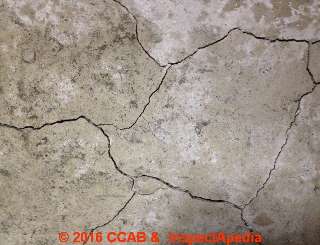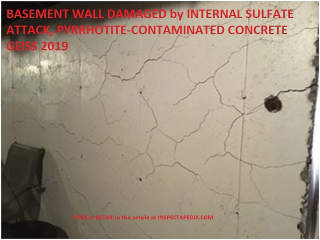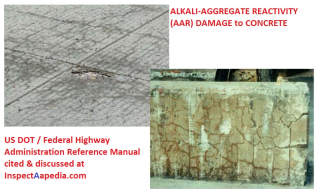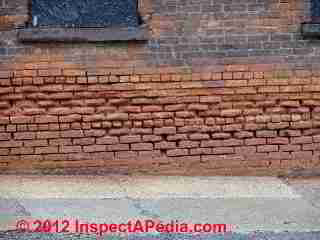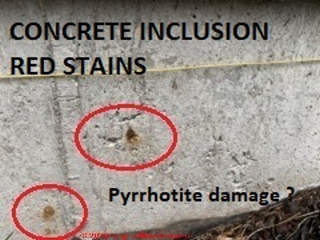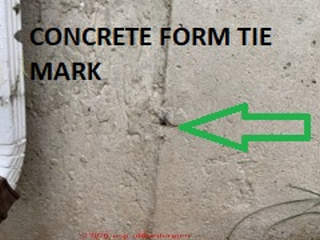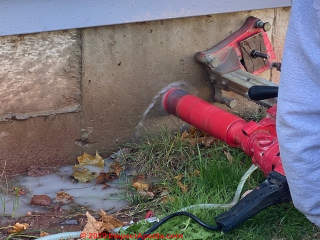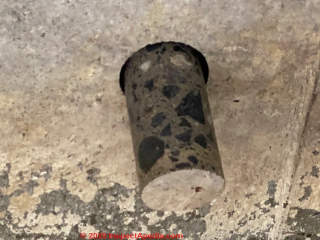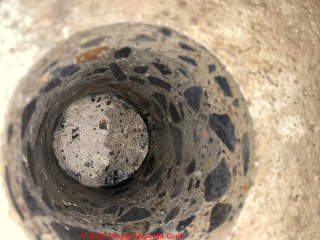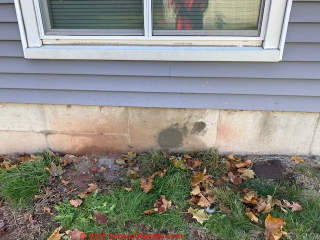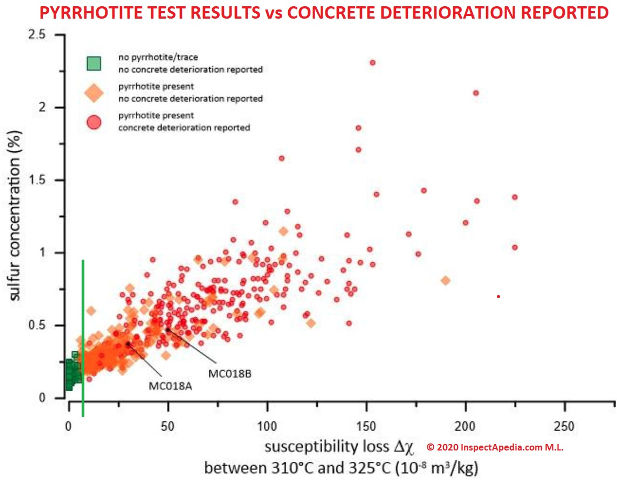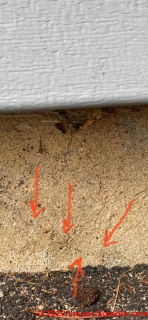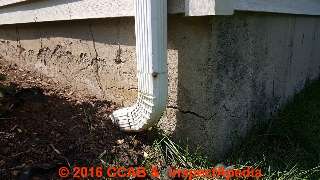 Foundation Damage Due to Composition or Inclusions
Foundation Damage Due to Composition or Inclusions
Foundation Cracks, Spalling, Stains caused by composition, iron sulfide pyrrhotite inclusions, steel, rust
- POST a QUESTION or COMMENT about the cause and repair of all types of building foundation damage
Foundation cracks or spalling due to choice of materials, contents, or inclusions:
Defects in concrete mix (too much water, for example), or defects in placement of steel or iron reinforcement (too close to surface, for example), as well as use of problem materials in concrete such as excessive levels of coal ash, cinders, or pyrrhotite an cause horizontal, vertical, or varied-pattern or "wandering" cracks in masonry or masonry block foundations.
Andrson & Cobb (2008) have reported similar serious structural damage occurring in structures built on top of shale containing pyrite and sulfates, producing severly-cracked foundation walls and floor slabs.
Page top photo of foundation cracks attributed to concrete that included iron sulfide (pyrrhotite), provided courtesy of CCACB - Connecticut Coalition Against Crumbling Basements. This article includes contact information for the CCAB as well as ctiations of authoritative research on the effects of iron sulfide in concrete. Click to enlarged this image and you'll also observe some spalling of the concrete surface.
Experts may refer to random pattern concrete cracks as damage caused by inclusions, iron, Other foundation damage such as rust heaving or staining, frost damage, or spalling may also be due to the specific component mix of the foundation material or for masonry or stone foundations damage may be due to composition, inclusions, or placement of reinforcement in the mortar joints.
InspectAPedia tolerates no conflicts of interest. We have no relationship with advertisers, products, or services discussed at this website.
- Daniel Friedman, Publisher/Editor/Author - See WHO ARE WE?
Foundation or Wall Cracking or Spalling Due to Foundation Materials or Contents

Iron sulfide mineral (pyrrhotite) cracking
Iron sulfide mineral (pyrrhotite) cracking may appear as variegated, "random pattern" cracking in concrete slabs, walls, and foundations whose concrete contains high levels of pyrrhotite. Moisture as well as oxygen react with this iron sulfide material, causing it to swell with tremendous force, causing varied-pattern cracking in the concrete.
Bryant in his thesis describes iron sulfide pyrrhotite cracking damage in several U.S. states including in Canada: Ottawa, in the U.K. in Derbyshire, and in the U.S. in Kentucky, Mississippi, Montana, Pennsylvania, Tennessee, Texas, Virginia, and more generally in the U.S. Great Plains area and in the Mississippian and Pennsylvanian shale beds.
Bryant notes that cases of "... heave due to oxidation of pyritic shale have been reported and continue to be reported worldwide. " (Bryant 2003).
[Click to enlarge any image] Photo: Pyrrhotite from the Santa Eulalia mine in Chihuahua, at Wikipedia - retrieved 2016/11/15, original source https://en.wikipedia.org/wiki/Pyrrhotite
The presence and nature of iron sulfides in mineral ores were discussed in North America as early as 1889 (Bailey), but as a factor in concrete and foundation damage iron sulfides and pyrrhotite were not discussed until there was more widespread of placed or poured concrete in building construction.
Foundation damage from the effects of iron sulfide inclusions has been discussed for more than half a century. Foundation and other concrete damage attributed to unstable iron sulfide was reported in Oslo in 1959 (Moum 1959)
Guillott warned about concrete problems ensuing from properties of some of the aggregates being used back in 1980 (Guillott 1980). Rodrigues and others discussed advanced testing methods to check concrete for mixtures that were at risk of harmful sulphur-bearing aggregates in concrete in 2015, and by 2016 those experts had specified a testing protocol to detect and avoid this trouble (Rodrigues and Ramos 2016).
Most recently pyrrhotite crack-damaged concrete foundations were reported by the New York Times in 2016 in explaining foundation damage in hundreds of U.S. homes in Connecticut.
Above: photo of foundation cracks attributed to concrete that included iron sulfide (pyrrhotite), provided courtesy of CCACB - Connecticut Coalition Against Crumbling Basements.
[Click to enlarge any image]
Concern with the effects of iron sulfide in concrete has been discussed by experts around the world including Australia, Britain, Canada, Ireland, Norway, Russia, the United States (in several states), and other countries.
All of the Connecticut homes affected by iron sulfide inclusion cracking were constructed using concrete provided by the Becker quarry in Willington CT. Becker quarry stone aggregate used in concrete contains high levels of pyrrhotite (iron sulfide).
According to the Times article similar damage has been reported in 4000 foundations of buildings in Quebec.
Above: another photograph of foundation cracks attributed to concrete that included iron sulfide (pyrrhotite), provided courtesy of CCACB - Connecticut Coalition Against Crumbling Basements.
We estimate that these phrrhotite cracks range from 1/8 to 3/16" in width.
But cracking ascribed to pyrrhotite or iron sulfide includsions in the concrete mix are sometimes as much as 1/2" in width according to the CCAB. See the photogarph just below, also provided provided courtesy of CCACB.
How to Diagnose Foundation Damage Attributed to Pyrrhotite Cracking
A spokesperson for the Connecticut Coalition Against Crumbling Basements (CCACB) who contributed photographs to this article commented by email that the owner of the home whose large foundation crack is shown above ..." is not aware of specific rebar or other matters that might affect the damage to that degree. ... the home [was] featured on NBC Nightly News , some homes have reached that degree of separation."
Really? OPINION: it seems likely that there will be differences between the fine cracks in concrete that are manifestations of generally weak concrete attributed to Iron sulfide mineral (pyrrhotite) inclusions ascribed to inclusions and the very large cracks and foundation displacement shown in the photograph.
Where there are big cracks there are additional forces at work such as footing or fill settlement, frost push, frost heaving, expansive clay heaving, construction on fill, inadequate footings, or
even SHALE FILL / HEAVE SETTLEMENT that involves significant settlement or heaving damage to foundations of buildings built on shale containing containing pyrite and sulfates.
Diagnosis of iron sulfide or phrrhotite concrete inclusion damage identification in the field would be aided by a catalog of indicators that could be confirmed visual inspection of the concrete, cracks in the concrete, the crack interior, or by concrete sampletesting. Such indicators could allow homeownes, contractors, and engineers to look at specific building cracks and damage to understand the cause of damage and the extent to which large cracks or foundation movement can be assigned in part or in whole to the inclusions.
For example, if you look inside the cracks with a good light, do we see concentrations of the problem material? Are there characteristivc stains like those identifiedf
at SHALE FILL / HEAVE SETTLEMENT ?
Watch out: Iron sulfide (pyrrhotite) crack pattern is often rather distinctive: look for a somewhat random cracking pattern, with concrete cracks that are wider and more continuous
than SHRINKAGE CRACKS at FOUNDATION WALLS.
Bérard (1975) and more recently Duchesne (2013) and Rodrigues (2012) offer clear explanations of how and why this pyrrhotite cracking damage occurs. We include summaries of the failure mechanism provided by abstracts to or excerpts from these and other articles cited below.
Rodrigues (2012) discusses mineralogical and chemical assessment of concrfete damaged by the oxidation of sulfied-bearing aggregates. But their analysis does not provide a field guide to damage assessment nor a guide to separating distinct causes of large foundation cracks such as the combination
- Concrete that is weak due to includes of sulfied-bearing aggregates, leading to fine cracks, spalling
- Concrete that has large cracks due to additional dislocating forces such as settlement, frost heave, earth loading or construction defects
Damages in concrete containing sulfide-bearing aggregates were recently observed in the Trois-Rivières area (Quebec, Canada), characterized by rapid deterioration within 3 to 5 years after construction.
A petrographic examination of concrete core samples was carried out using a combination of tools including: stereomicroscopic evaluation, polarized light microscopy, scanning electron microscopy, X-ray diffraction and electron microprobe analysis.
The aggregate used to produce concrete was an intrusive igneous rock with different metamorphism degrees and various proportions of sulfide minerals. In the rock, sulfide minerals were often surrounded by a thin layer of carbonate minerals (siderite).
Secondary reaction products observed in the damaged concrete include “rust” mineral forms (e.g. ferric oxyhydroxides such as goethite, limonite (FeO (OH) nH2O) and ferrihydrite), gypsum, ettringite and thaumasite. In the presence of water and oxygen, pyrrhotite oxidizes to form iron oxyhydroxides and sulphuric acid.
The acid then reacts with the phases of the cement paste/aggregate and provokes the formation of sulfate minerals.
Understanding both mechanisms, oxidation and internal sulfate attack, is important to be able to duplicate the damaging reaction in laboratory conditions, thus allowing the development of a performance test for evaluating the potential for deleterious expansion in concrete associated with sulfide-bearing aggregates. - Rodrigues (2012)
Photos & field damage reports wanted: random foundation crack patterns, Pyrrhotite crack-damaged concrete foundations in Connecticut or Quebec or elsewhere. CONTACT us by email.
Foundation & Structural Damage to Buildings Constructed on Shale Containing Pyrite & Sulfates
Examining how pyrite and sulfites in shale can cause building problems may give added insight to how fragments of these materials may cause trouble when mixed right into concrete as aggregate. Shale formations in at least 20 U.S. states containing various clay and iron sulfide minerals (pyrite) react to water and form mild sulfuric acid causing unstable shale and clay formations.
Structural problems develope as a result of expansive clay soils and heaving. Some heaving damage is traced to pyrite oxidation and sulfate formation while other expansive soil damage is commonly traced to expanding clay soils or expanding clay in shale.
Also
see FOUNDATION FAILURES in CLAY SOIL
Andrson & Cobb (2008) have reported serious structural damage occurring in structures built on top of shale containing pyrite and sulfates, producing severly-cracked foundation walls and floor slabs.
Pyrite oxidation in the Chattanooga Shale has caused serious foundation problems in numerous buildings and structures in Estill County, Ky. Pyrite oxidizes and various secondary sulfates form when excavated shale or shale fill are used in foundations. These secondary sulfates are water- and humidity-sensitive and can form when only minor amounts of water are present in foundation materials.
These sulfates form by crystal growth and expand by volume change, which causes subsequent soil expansion and heaving of any foundation materials when the materials are confined. Several structures have undergone expensive remediation to repair damaged sidewalks, floors, walls, and foundations.
Zones of high concentrations of pyrite occur in the Chattanooga Shale across the state, and these mineral zones may be responsible for the high pyrite content in Estill County. - Anderson & Cobb (2008)
Anderson describes significant foundation and structural damage to three large buildings buit north of Irvine in Estill County, Kentucky in the U.S.: The Carhartt factgory, the Estill County Middle School, and the Marcum and Wallace Hospital auxiliary building.
These buildings are constructed on top of the Devonian Chattanooga Shale formation. Similar swelling/heaving damage to a state highway, KY 499, built over the Crab Orchard Formation (underlying the Chattanooga Shale) was also reported.
The Chattanooga Shale in this area has a high pyrite content, which oxidizes into various efflorescent (powder-like) sulfate minerals.
What is commonly called pyrite swelling is actually a chemical oxidation reaction between groundwater and pyrite. Many sulfates form from this chemical reaction, but two of the most common are jarosite and copiapite. Jarosite, an iron sulfate, is a mineral salt and copiapite is a calcium-iron sulfate with a distinctive yellow color. - op. cit.
Watch out: other more subtle damage due to settlement, heaving, or floor, wall or foundation movement may be extremely dangerous if it causes dislocations in and damage to gas piping, electrical wiring, heating systems, chimneys, or other building mechanical systems.
In my [DF] opinion even a small dislocation that risks rupturing a gas line risks fire or explosion similar to hazards occurring in earthquake zones.
Visual or Historical Evidence of Building Damage Possibly Related to Construction on Shale Containing Pyrites & Sulfites
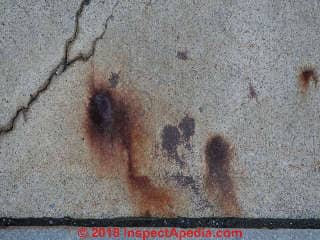 Iron, Sulfur, & Phrrhotite-Contamiatned Concrete Cracking Failures are further described here.
Iron, Sulfur, & Phrrhotite-Contamiatned Concrete Cracking Failures are further described here.
Concrete Stains and Cracking associated with rusting iron or steel or slag steel inclusions in the concrete material, either by deliberate inclusion as reinforcement, or by accident such as stones or scrap containing iron that are later exposed to water and possibly freezing cycles.
Our red rust stains on the concrete sidewalk shown above were found on the Vassar College campus in Poughkeepsie NY.
Watch out: rusting and exfoliation of iron inclusions in poured concretre structures can lead to very costly damage.
In the U.S., pyrrhotite-contaminated concrete in Connecticut has been blamed on a significant number of foundation failures in homes constructed in the 1980s using iron-contaminated concrete.
The iron or phrrhotite contamination issue is not a new one and has occurred outside the U.S. as well.
Lugg (1996) cites similar damage in Cornwall and Devon in the U.K. between 1900 and 1950.
Where poured concrete cracking is attributed to an internal sulfate attack in iron pyrrhotite-contaminated concrete, such as in the photo below (Geiss 2019) you will notice that red rust staining is not at all visible.
Other tests including as described by Geiss (2019) can however reliably diagnose this condition.
Research on pyrrhotite-contaminated concrete damage
- INCLUSIONS in STONE MISTAKEN FOR NAILS? iron inclusions in stone can be confusing
- Belzile, Nelson, Yu-Wei Chen, Mei-Fang Cai, and Yuerong Li. "A review on pyrrhotite oxidation." Journal of Geochemical Exploration 84, no. 2 (2004): 65-76.
- Böhni, Hans, ed. Corrosion in reinforced concrete structures. Elsevier, 2005.
- Chakrabarti, S. K., and A. Kumar. "Leakage through concrete-steel interfaces at and around containment penetration assemblies: some new observations." In Proceedings of the international topical meeting on advanced reactors safety: Volume 2. 1997.
- Geiss, Christoph E., and Jonathan R. Gourley. "A thermomagnetic technique to quantify the risk of internal sulfur attack due to pyrrhotite." Cement and Concrete Research 115 (2019): 1-7.
- Geiss, Christoph E., and J. R. Gourley. THERMOMAGNETIC ANALYSES TO TEST CONCRETE STABILITY [PDF] In AGU Fall Meeting Abstracts. 2017. Also appearing in Cement and Concrete Research Volume 115, January 2019, Pages 1-7, retrieved 2018/12/-01, original source: https://www.sciencedirect.com/science/article/pii/S0008884618301455
Abstract The use of pyrrhotite-containing aggregate in concrete has led to the premature deterioration of building foundations in Connecticut (U.S.A.).
Pyrrhotite is a highly reactive iron-sulfide mineral that can initiate internal sulfate attack in concrete structures, because it serves as a source of sulfate ions for secondary minerals. Associated increases in mineral volume can lead to spalling, cracking and a loss of structural integrity.
Since pyrrhotite is a strongly ferrimagnetic mineral with a Curie-temperature of 325 °C and several diagnostic phase transitions, we measured the variation of magnetic susceptibility between room-temperature and 700 °C. Such a thermomagnetic measurement serves as a rapid and sensitive semi-quantitative indicator of pyrrhotite in aggregate or concrete samples.
In combination with measurements of total sulfur concentrations, pyrrhotite concentrations as low as 0.1% can be detected.
The analysis can aid in the quantification of risk of internal sulfur attack due to the presence of pyrrhotite. - Gourley, Jonathan R., and C. E. Geiss. "Combining Mineral Identification Techniques to Help Homeowners of Northeastern Connecticut Diagnose Pyrrhotite Laced Concrete Foundations." In AGU Fall Meeting Abstracts. 2017.
- Hussey, Kristin, & Lisa W. Foderaro, With Connecticut Foundations Crumbling, ‘Your Home Is Now Worthless The New York Times, 7 June 2016, retrieved 2018/12/01 original source: https://www.nytimes.com/2016/06/08/nyregion/with-connecticut-foundations-crumbling-your-home-is-now-worthless.html
Excerpt: Across nearly 20 towns in northeastern Connecticut, a slow-motion disaster is unfolding, as local officials and homeowners wrestle with an extraordinary phenomenon. Hundreds, possibly thousands, of home foundations that have been poured since the 1980s are cracking, with fissures so large you can slip a hand inside. - Kock, Dagmar, and Axel Schippers. "Geomicrobiological investigation of two different mine waste tailings generating acid mine drainage." Hydrometallurgy 83, no. 1-4 (2006): 167-175.
- Lugg, Andrew, and Doug Probert. "‘Mundic’-type problems: a building material catastrophe." Construction and Building Materials 10, no. 6 (1996): 467-474.
Abstract:
During the period ad 1900–1950, readily-available mining spoils, specifically mundic and killas rocks, were used as aggregates in concrete in order to keep building costs low.
Unfortunately this choice of materials, especially in Cornwall and Devon, had led subsequently to the occurrence of many structural faults.
Consequently the affected buildings have experienced significant losses in financial value and some have even had to be demolished because they were unsafe.
The deleterious process in the concrete ensues as a reaction with water: thus one of the primary means to try to reduce its severity is to maintain the concrete in a dry condition. - Schippers, Axel, Dagmar Kock, Michael Schwartz, Michael E. Böttcher, Horst Vogel, and Mike Hagger. "Geomicrobiological and geochemical investigation of a pyrrhotite-containing mine waste tailings dam near Selebi-Phikwe in Botswana." Journal of Geochemical Exploration 92, no. 2-3 (2007): 151-158.
- Zhong, Rui, and Kay Wille. "Deterioration of residential concrete foundations: The role of pyrrhotite-bearing aggregate." Cement and Concrete Composites 94 (2018): 53-61.
Visual evidence of buildings for damage and for evidence of pyrite and sulfites as root-cause contributors to this damage included the items listed below. Many of these inspection points of damage could have very different underlying causes.
- Concrete retaining wall bulging, mineral precipitates in tension cracks as well as in drainage openings in the retaining wall (well-illustrated in this article)
Also see RETAINING WALL DAMAGE - Cracks visible in floors, walls, ceilings or prior repairs of them
- Cracks along door frames and elevator shaft opening frame
- Cracks, gaps, heaved floor. Long wide cracks through a concrete floor slab may telegraph up through floor tiles. Crack pattern tends to wander but may be more or less along a particular axis representing the high point of a bulge of heaved soil below the slab.
- Cracks in masonry veneers on exterior walls
- Construction on shale fill material may be a major contributor to damage, particularly if the fill is subsequently wet by roof or surface runoff.
- Drainage: [Possilby, opinion of DF] poor control of roof runoff or surface runoff, allowing water to saturate the shale under and around the building - similar to expansive clay soil problems.
- Floors out of level ( a teacher's desk drawer opens by gravity)
- Foundation-related damage occurring in interior floors, walls, ceilings, sidewalks, roadways, parking lots, and retaining walls.
- Heaved sidewalks, roadways, parking lots, or replaced or repaved sidewalks, roads, parking areas
- Interior or exterior doors that do not close because of floor heaving, or doors that have been under-cut to clear heaved, uneven floors
- "Offsets", step cracking, in masonry block walls, vertical cracks in concrete walls, varigated cracks in concrete walls, floors, foundations
- Plumbing leaks in supply or drain piping traced to pipes damaged by building movement
- Repairs: evidence of or history of previous repair work to similar damage at the buildings
- Stains: red-iron staining, sulfate staining (red-yellow), and mineral residues (may also be white or yellowish) at cracks and drain openings or at points of water leakage through floor slabs or foundation walls:
"Massive pyrite oxidation occurring in the shale leaches minerals, including sulfates, sulfur, and iron, into Masters Creek, resulting in low pH, high sulfate, and significant iron-staining in the creek. The outcrop behind the school is red-stained with iron oxide precipitates." - Op. Cit. - Visibly heaved basement or on-grade level floor slabs.
Technical Evidence of Building Damage Possibly Related to Construction on Shale Containing Pyrites & Sulfites
- Engineering and geologist studies of the underlying geology of the site
- Core borings to collect diagnostic mineral samples of shale to evalute its composition, possibly using X-ray diffraction and fluoresence. Sulfate analysis. Analysis to determine levels of and variations of iron and sulphur in the substrate.
- Presence of construction over the Devonian Chattanooga Shale formation, particularly when the shale is at or near the surface. Shale layers range from 20 to 160 feet in thickness, including a layer that is visible at or close to ground surface as well as at highway or construction excavations and cuts. Of course there are also scholarly studies of these formations and their properties.
Technical Explanation of Why Construction on Shale Fill High in Iron Sulfide, Phrrhotite, Pyrites Causes Damage
Anderson explains that construction on shale fill material may be a major contributor to damage, particularly if the fill is subsequently wet by roof or surface runoff. He describes three underlying causes of foundation failure for the buildings studied:
- Oxidation of pyrite and growth of secondary sulfates in the shale is listed by the author the primary cause of foundation
problems [in this construction area]. A more mechanical explanation is that crystals form in the material, increasing its volume and producing tremendous heaving or expansion forces.
The sulfates, plus water, also produces mild sulfuric acid that may contribute to foundation failiures. I think similar forces may occur within a poured concrete component high in similar materials as aggregate. - Un-stable soils: shale degrades into clay and sulfate minerals to form an un-stable soil lacking in shear strength.
- Construction on shale fill: Anderson explains both why shale fill with these properties causes trouble and also why we may see worse heaving and damage in floor centers and in non-load-bearing partitions.
... [Shale fill material high in pyrite and perhaps sulphur] weathers rapidly, and causes the pyrite to oxidize to sulfates very rapidly. The primary cause of these structural failures is pyrite oxidation, also called pyrite swelling, which creates secondary sulfate growth beneath the slab foundation, causing floor heaving, wall and flooring cracking, and structural instability.
This pyrite oxidation leads to crystal growth that can crack concrete and lift foundations.
Normally, the load-bearing walls in these structures exert enough load or pressure on the expanding pyrite to balance the strength of crystal growth within the sulfate in the shale, so that the load-bearing walls do not move, but the adjacent slab flooring does move. - Op. Cit.
More information on iron sulfide pyrrhotite cracking damage to foundations:
- CONCRETE REINFORCEMENT, FIBER - research + an example of slab cracking that might be due to iron sulfide pyrrhotite or similar inclusions.
- Anderson, Warren H. "Pyrite Oxidation and Structural Problems in the Chattanooga (Ohio) Shale, East Central Kentucky." In Implications of Pyrite Oxidation for Engineering Works, pp. 243-273. Springer International Publishing, 2014. Online as PDF,
- Anderson, Warren H., Cobb, James C., "Foundation Problems and Pyrite Oxidation in the Chattanooga Shale, Estill County, Kentucky" [PDF] Kentucky Geological Survey James C. Cobb, State Geologist and Director University of Kentucky, Lexington, REport of Investigations 18, Series XII, 2008, ISSN 0075-5591 at University of Kentucky, retrieved 2016/11/15, original source: http://kgs.uky.edu/kgsweb/olops/pub/kgs/ri18_12.pdf
- Bayley, William Shirley. A Summary of Progress in Mineralogy and Petrography... No. 7-11. 1889.
- Bérard, Jean, Richard Roux, and Marc Durand. "Performance of concrete containing a variety of black shale." Canadian Journal of Civil Engineering 2, no. 1 (1975): 58-65.
Abstract:
The combined mechanisms of oxidation of iron sulfides followed by sulfatation of both the surrounding calcite and the hydration products of Portland cement are well known. Nevertheless, cases where important breakdown of concrete structures have occurred, with less than 2% shale in the coarse aggregate fraction seem to be very rare.
Based mainly on petrographic examination, the expansive mineral phases were identified in the black shale and in the concrete paste.
It is believed that sulfuric acid, formed within the shale by oxidation of the pyrrhotite, has transformed the calcite into gypsum. In the concrete, this newly formed gypsum or that formed by sulfatation of the portlandite Ca(OH)2 has reacted in turn with the tricalcium aluminate of the cement paste to form ettringite.
Both reactions, within the shale or with the cement paste, occur with an important volume increase. - Bérubé, M.A., Frenette, J., Rivest, M. 2002. "Laboratory Assessment of the Potential Rate of ASR Expansion of Field Concrete.” Cement, Concrete, and Aggregates, 24 (1), 28-36.
- Bhatti, Tariq M., Jerry M. Bigham, Liisa Carlson, and Olli H. Tuovinen. "Mineral products of pyrrhotite oxidation by Thiobacillus ferrooxidans." Applied and Environmental Microbiology 59, no. 6 (1993): 1984.
- Blight, Geoffrey E., and Mark G. Alexander. Alkali-aggregate reaction and structural damage to concrete: engineering assessment, repair and management. CRC Press, 2011.
- Bryant, Lee Davis, Matthew Mauldon, and James Kenneth Mitchell. Geotechnical problems with pyritic rock and soil. Virginia Polytechnic Institute and State University, Charles E. Via Department of Civil Engineering, 2003.
- Bryant, Lee Davis. "
Geotechnical problems with pyritic rock and soil." (2003). [PDF] Thesis for MS in Civil Engineering, retrieved 2017/08/03, original source: https://theses.lib.vt.edu/theses/available/etd-05212003-173107/unrestricted/ThesisAll.pdf
Abstract:
Oxidation of pyrite can significantly affect properties and the behavior of soil and rock in civil construction.
Problems with pyritic rock and soil extend globally and across many disciplines. Consequences of pyrite oxidation include heave, concrete degradation, steel corrosion, environmental damage, acid mine drainage, and accelerated weathering of rock with concomitant effects on strength and stability.
Affected disciplines include soil science, mining, engineering geology, geochemistry, environmental engineering, and geotechnical engineering.
While pyrite problems may be well known in their respective disciplines, there has been to date relatively little cross-disciplinary communication regarding problems with pyritic geomaterials.
Thus, there is a need to establish an inter-disciplinary and inter-regional awareness regarding the effects of pyrite oxidation and their prevention or mitigation.
This engineering research is a compilation of information about geotechnical problems and engineering behavior of pyritic rock and soil, the underlying physicochemical processes, site investigation strategies, and known problematic formations.
Several case histories documenting consequences of pyrite oxidation are provided. The results of chemical analyses performed on pyritic shale samples from a formation with acknowledged heave problems are presented.
Digital data and ESRIâ s ArcGIS digital mapping program were used to create maps showing results of sampling and testing performed during this study.
Appendices include mitigation options, results of a practitioner survey, chemical test procedures, a glossary, a visual identification key for sulfidic geomaterials, and a summary table of the literature review for this research. - "Connecticut Coalition Against Crumbling Basements", Email: info@ccacb.org, Website: https://ccacb.org/
Website Excerpts:
The Connecticut Coalition Against Crumbling Basements (CCACB) is a grassroots alliance committed to providing a voice for victims of failing concrete in our region. - Chanturiya, V. A. "Contemporary problems of mineral raw material beneficiation in Russia." Journal of Mining Science 35, no. 3 (1999): 314-328.
- Duchesne, Josée, and Benoît Fournier. "Deterioration of Concrete by the Oxidation of Sulphide Minerals in the Aggregate." Journal of Civil Engineering and Architecture 7, no. 8 (2013): 922.
Abstract:
Cases of degradation of concrete associated to iron sulphides in aggregates were recently recognized in the Trois-Rivières area, Canada. The aggregate used to produce concrete was an anorthositic gabbro containing various proportions of pyrite, pyrrhotite, chalcopyrite and pentlandite.
Quantitative microanalysis on sulphide minerals show that pyrrhotite contains small amount of Ni, Co, Cu and As substituting for Fe in the mineral structure.
Considering element substitution, x value in the chemical formula (Fe1-xS) was calculated to 0.099 in the pyrrhotite studied. Petrographic examination of damaged concretes showed the presence of oxidized pyrrhotite.
The observation of polished samples shows, in several cases, that the pyrite is intact while the pyrrhotite presents evident signs of oxidation.
In the presence of water and oxygen, pyrrhotite oxidizes to form iron oxyhydroxides and sulphuric acid.
The acid then reacts with the phases of the cement paste and provokes the formation of gypsum and ettringite. These minerals were observed by SEM-EDS (scanning electron microscope/energy dispersive x-ray spectrometer) and their precipitation causes a volume increase that creates expansion and cracking of the concrete. - Gillott, J. E. "Properties of aggregates affecting concrete in North America." Quarterly Journal of Engineering Geology and Hydrogeology 13, no. 4 (1980): 289-303.
Summary
Aggregates compose the largest single component in concrete and significantly affect its strength, durability and appearance. The mechanical properties of concrete are affected by the strength of the cement-aggregate bond and by other factors such as texture and soundness of the rock. External agencies attack concrete and reduce its durability by both physical and chemical processes.
Physical mechanisms include cyclical freezing and thawing, wetting and drying. Chemical deterioration results from reaction with sulphate-bearing waters, acids, a marine environment, industrial effluents and similar corrosives.
Internal compatibility is essential, as deleterious interaction between concrete constituents may cause poor durability, as in the case of expansive alkali-aggregate reactions. Deliberate exposure of aggregates, sometimes used architecturally, may give concrete a pleasing appearance, but localized stains from weathering of aggregate particles lead to an unsightly appearance.
Relatively few attempts have been made to improve aggregate properties artificially and ‘unsound’ aggregate is simply rejected.
Depletion of good quality supplies near major centres of construction suggests that more pre-treatment of marginal aggregates may become economically attractive in the future. - Hawkins, A. Brian, and Thomas W. St John. "Iron sulphides and surface heating: further engineering considerations for the Dublin area." In Implications of Pyrite Oxidation for Engineering Works, pp. 275-307. Springer International Publishing, 2014.
- Kemp, James Furman. A Handbook of Rocks: For Use Without the Microscope. Author, 1896.
- Kristin Hussey, Lisa W. Foderaro, "With Connecticut Foundations Crumbling, 'Your Home is Now Worthless'", The New York Times, 7 June 2016, retrieved 2016/11/15, original source: http://www.nytimes.com/2016/06/08/nyregion/with-connecticut-foundations-crumbling-your-home-is-now-worthless.html?_r=0
- LaGanza, Richard F. "Pyrite investigations at Nairne, South Australia." Economic Geology 54, no. 5 (1959): 895-902.
- Lindgren, Waldemar. Mineral deposits. McGraw-Hill Book Company, Incorporated, 1913.
- Lisa W. Foderaro, Kristin Hussey, "Financial Relief Eludes Connecticut Homeowners with Cracking Foundations", The New York Times, A24, A28, 15 Nov. 2016
- Maher, Michael LJ. "The Canadian Pyrite Experience and Comparisons with the Irish Problems." In Implications of Pyrite Oxidation for Engineering Works, pp. 207-241. Springer International Publishing, 2014.
- Maher, Michael LJ. "The Canadian pyrite experience and comparisons with the Irish problems." Implications of Pyrite Oxidation for Engineering Works (2013): 207.
- Moffit, Fred Howard. Mining in the lower Copper River basin. US Government Printing Office, 1918.
- Moum, Johan, and I. Th Rosenqvist. "Sulfate attack on concrete in the Oslo region." In Journal Proceedings, vol. 56, no. 9, pp. 257-264. 1959.
Abstract:
In the Oslo region of Norway, alum shales containing small amounts of the unstable iron sulfide, pyrrhotite, pro- duce an unusual form of sulfate attack upon concrete placed in or near these deposits, and cause deterioration if they are used as concrete aggregate.
The ground water associated with the alum shales carries ferrous sulfate and produces severe sulfate attack and the precipitation of ferric iron compounds in concrete structures made with normal portland cement. Cements of low tricalcium aluminate content resist the sulfate attack but may be subject to attack by acid solutions produced when the ferrous sulfate is oxidized. Air-entrained concrete appears to be particularly susceptible. - I. Oliveira, S.H.P. Cavalaro, A. Aguado, "Evolution of pyrrhotite oxidation in aggregates for concrete", [PDF] Materiales de Construcción
Vol. 64, Issue 316, October–December 2014, e038
ISSN-L: 0465-2746
http://dx.doi.org/10.3989/mc.2014.08413, retrieved 2016/11/15, original source: http://materconstrucc.revistas.csic.es/index.php/materconstrucc/article/viewFile/1670/2013
Abstract:
Rocks containing pyrrhotite bands are sometimes used to produce concrete. These rocks oxidize and produce long-term expansive reactions that damage concrete structures, leading to important economic and risk related repercussions.
The present study analyses several aspects that affect the oxidation process of the aggregate such as the existence of preferential paths for the entrance of the oxidizing agent and the conversion process of the chemical elements involved in the reaction.
For that, host rock samples containing pyrrhotite were investigated by scanning electron microscopy and energy dispersive spectroscopy. The results shows that the pyrrhotite appears in bands that create planes of weakness and present cracks that serve as preferential paths for the entrance of oxygen. Furthermore, a new representation is proposed for the oxidation process. - Ramos, Violeta, Andreia Rodrigues, Benoît Fournier, and Josée Duchesne. "Development of a quick screening staining test for detecting the oxidation potential of iron sulfide-bearing aggregates for use in concrete." Cement and Concrete Research 81 (2016): 49-58.
- Richards, Robert Hallowell. A Text book of ore dressing. McGraw-Hill book Company, 1909.
- Rodrigues, A., J. Duchesne, B. Fournier, B. Durand, M. H. Shehata, and P. Rivard. "Evaluation Protocol for Concrete Aggregates Containing Iron Sulfide Minerals." ACI Materials Journal 113, no. 3 (2016).
- Rodrigues, A., J. Duchesne, and B. Fournier. "A new accelerated mortar bar test to assess the potential deleterious effect of sulfide-bearing aggregate in concrete." Cement and Concrete Research 73 (2015): 96-110.
Abstract
Deterioration of concrete structures incorporating sulfide bearing aggregates has been reported in Trois-Rivières area, Québec, Canada. In this case, iron sulfide oxidation and internal sulfate attack were observed. The present study aims at developing a performance test that will reproduce, in the laboratory, the deterioration mechanisms observed on site.
A two-phase accelerated mortar bar test was developed that consists 90 days of storage at 80 °C/80% RH, with two 3-h wetting cycles in a 6% bleach solution (Phase I) followed by up to 90 days of storage at 4 °C/100% RH (Phase II).
Aggregates with oxidation potential presented an expansion over 0.15% during Phase I, while thaumasite formation potential is detected by rapid regain of expansion followed by destruction of the samples during Phase II. The control aggregates without sulfide mineral did not show any signs of deterioration in both phases of the testing program. - Rodrigues, A., J. Duchesne, B. Fournier, B. Durand, P. Rivard, and M. Shehata. "Mineralogical and chemical assessment of concrete damaged by the oxidation of sulfide-bearing aggregates: Importance of thaumasite formation on reaction mechanisms." Cement and Concrete Research 42, no. 10 (2012): 1336-1347.
- Shrimer, F. H. "Geomechanics of Heave due to the Use of Pyritic Mudstone, Ireland." In 50th US Rock Mechanics/Geomechanics Symposium. American Rock Mechanics Association, 2016.
- Subrahmanyam, T. V., and K. S. E. Forssberg. "Mineral solution-interface chemistry in minerals engineering." Minerals Engineering 6, no. 5 (1993): 439-454.
- Tagnit-Hamou, Arezki, Mladenka Saric-Coric, and Patrice Rivard. "Internal deterioration of concrete by the oxidation of pyrrhotitic aggregates." Cement and Concrete Research 35, no. 1 (2005): 99-107.
Abstract
This paper presents research results on the causes of a severe concrete deterioration, which occurred in many building foundations approximately 2 years after construction.
Concrete samples were investigated with X-ray diffraction (XRD) analysis, a scanning electron microscope (SEM) and a petrographic examination performed with a stereomicroscope. It was found that the early cracking of concrete stemmed from the oxidation of the pyrrhotite found in the anorthosite aggregates used to produce the concrete.
The oxidation process led to the precipitation of iron hydroxides having a higher volume than the original pyrrhotite does. The presence of micas (biotite) close to the pyrrhotite seemed to promote and accelerate the oxidation process.
- US DOT, ALKALI-AGGREGATE REACTIVITY (AAR) WORKSHOPS FOR ENGINEERS AND PRACTITIONERS Reference Manual [PDF] (2012) US Department of Transportation, Federal Highway Administration,
- Wager, Lawrence Rickard, Ewart Albert Vincent, and Albert Arthur Smales. "Sulphides in the Skaergaard intrusion, east Greenland." Economic Geology 52, no. 8 (1957): 855-903.
Foundation Cracking Due to Reinforcing Steel Placement
Rust & Frost Horizontal cracking and heaving may appear at masonry unit (brick or concrete block) mortar joints if leaks cause steel reinforcing mesh or re-bar to rust.
Exfoliating rust has tremendous lifting power as does frost that may damage masonry foundations that are already cracked and then wet. Rust damage may be severe above improperly-sealed steel window & door lintels.
Rust staining and damage may also occur to stone structures due to inclusions in the stone itself.
More information on red stains, rust & frost damage cracking to foundations
Spalling Damage to Foundations
Spalling damage occurs at poorly-mixed concrete walls, floors, slabs, walls.
Spalling damage also occurs on concrete block "cinder block" made from poor-quality material such as using too-little cement or too much aggregate that contains high levels of iron or other contaminants.
Spalling damage occurs in brick foundations when the brick surface has become soft, damaged by sand-blasting, and when it then absorbs water, especially in freezing climates.
This article series provides a guide to identifying & evaluating different types of concrete or masonry foundation, wall or floor cracks in buildings: this article series describes how to recognize and diagnose various types of foundation failure or damage, such as foundation cracks, masonry foundation crack patterns, and moving, leaning, bulging, or bowing building foundation walls.
Foundation cracks and movement are discussed by type and location of foundation cracks, vertical foundation cracks, horizontal cracks, and diagonal foundation cracks, and shrinkage cracking.
...
Reader Comments, Questions & Answers About The Article Above
Below you will find questions and answers previously posted on this page at its page bottom reader comment box.
Reader Q&A - also see RECOMMENDED ARTICLES & FAQs
Question: my engineer found Pyrrhotite damage, cracks, stains on my 30 year old Connecticut house - I'm not sure he's correct
These are visual inspection photos of my 1990 raised ranch (30 years old). The PE inspector who received his license in February 2020 evaluation determined that this is very possibly pyrrhotite damage.
I'm not an engineer, but based on your photos, my gut is having a problem with that eval. Any thoughts? - Anonymous by private email 2020/11/04
Moderator reply:
Above: this opening in a concrete wall is doubtless from a concrete form tie; note that it appears in line with the concrete form joint marks on the foundation wall exterior. These may also be found at the corresponding location inside the building.
I'll look at all of your images again at a more leisurely time. But what I see in the top ones in your photos are concrete form joint marks (shown below) and form tie marks in the wall (shown above).
From my too-limited view (photos too small, lack detail and I can't be smarter than your on-site experts) for most of your photos, in my OPINION there is little or no damage from an inclusion - perhaps the inspector is inexperienced in the field of concrete and concrete foundations.
In some of your photos there's white effloresence - so there's water involved - EFFLORESCENCE SALTS & WHITE DEPOSITS - shown below.
Look for rain splash-up damage along the foundation in this area and for other evidence of gutter overflows.
And one photo (below) has what looks almost like reddish mud (I'd double check that there's not termite mud tubes though this looks more like mud splash).
Reader follow-up:
That was my thought exactly. I also noticed that the gray epoxy dripped down to the cement cluster that follows the base where floor meets wall calling that honeycombing. That would mean it honeycombed before the epoxy was put on 30 years ago when the house was built.
I’m baffled by his evaluation results that he believes this is a Pyrrhotite issue. I questioned his knowledge as a structural foundation deterioration engineer. He wasn’t happy.
... I'm having my son check it out as I am in Florida at this time. He will also attend the core removal. A 3 inch diameter hole concerns me. Even though they plug it with hydraulic cement, I fear it will still compromise that area since that are is the slab section and has a very short wall. But, I guess for everyone's peace of mind, it has to get done ... I'll send you the results.
Moderator reply:
I went through all of your tiny photos and saw one that has red rust marks from what may be an inclusion - shown below:
That's the only one I could find.
I can't in your one photo rule pyrrhotite inclusion in or out as we lack details and a larger image, but if there is going to be testing this is a spot to test.
Usually if there is a pyrrhotite including problem we see quite a few more such spots in the foundation wall surfaces;
Also I did not see any of the variegated foundation cracks that we show in our pyrrhotite article cited below. (Cracks may be present but I couldn't see them in the images.)
Keep in mind that an occasional bit of slag or even iron scrap gets into concrete and will also cause rust stains on masonry or concrete.
Photos at Foundation Damage Due to Composition or Inclusions - Foundation Cracks, Spalling, Stains caused by composition, iron sulfide pyrrhotite inclusions, steel, rust discussed above on this page.
Other examples of red stains on various masonry surfaces that are not pyrrhotite inclusions but are from other sources of iron are in a photo or two are shown
at STAINS on STONE, STUCCO DIAGNOSE & CURE - including red & rust stains on various types of masonry
I'm not a P.E. though I've had an engineer job title and some of my real-engineer friends call me one too - which I now take as a compliment. But I've taught engineers and architects and I therefore can argue that in a typical undergraduate engineering degree there's little in about residential construction and less on residential construction failures and defects.
Even for a P.E. who is practicing within her area of education and license (such as structural or mechanical) that level of detail usually comes from mentors and from field experience.
Frankly from what I've seen so far I'm a bit worried that this is an example of the OPM problem - see
OTHER PEOPLE's MONEY - consultants spend your money to reduce their risk (of being blamed later for an unlikely outcome)
Considering that you don't want to have the inclusion issue with your home I almost hope that the OPM problem is the case here.
Really? Keep in mind that if a thorough inspection of a 30 year old foundation finds
- no structural cracking (just some surface spalling)
- just one or two red rust inclusion spots
- no signs of structural movement or other damage
then the probability that there is Pyrrhotite inclusion damage to the foundation seems rather small.
Reader follow-up: Photos of foundation sample core drilling to test for pyrrhotite aggregate inclusion damage in Connecticut
OPINION: I’m thinking that it was a political move to protect banks and insurance companies by saying Pyrrhotite aggregate was used in cement and therefore not a natural disaster. Get funds from feds to help homeowners as many walked away.
Below: Photos of the collection of a foundation core sample for lab analysis for Pyrrhotite aggregate damage to the foundation. The contractor uses a concrete core sampling drill to cut a core sample through the foundation wall so as to include one of the red inclusions to be analyzed.
Below we can see the quality and condition of the cross-section of the concrete foundation wall where this core sample was collected.
Moderator reply:
Looking at the cross section of the core sample and the core hole drilled and noting the absence of any visible cracks in the concrete the foundation looks pretty good to me where tested.
We'll see what the experts have to add.
Reader follow-up:
Trinity College does the lab work and U. Conn. received $768,000 of a $1.5 million Federal grant.
Here is a copy of the expert's report on the analysis of the concrete core sample for Pyrrhotite aggregate damage.
- PYRRHOTITE AGGREGATE PRESENCE TEST & DAMAGE REPORT [PDF] (2020/11/11)
Below: test results for the concrete core sample described above.
Below: placement of the test results for the concrete core sample tested vs. population of prior tests by the same laboratory.
Discussion and OPINION of the Engineer's Inspection and Lab Test Results above:
Reader Comment:
I’ve tried to research what those numbers mean, but it seems to get me nowhere. He is saying pyrrhotite deterioration based on the PE’s report because he says mapping.
But doesn’t say whether or not it’s due to shrinkage or other causes.
And the PE wouldn’t say it was caused by pyrrhotite until the core test showed pyrrhotite.
Like they are using one another to satisfy their determinations. That mapping is the size of my hand. I’m at a loss.
Moderator Reply:
Bottom line: the report supports your engineer's conclusion that there is pyrrhotite damage to your foundation. But more needs to be said.
In reaching that conclusion the lab relies on combining two critical bits of data:
1. the lab test for presence of sulphur in the sample that can indicate the presence of pyrrhotite
COMBINED with
2. the engineer's report that there was visual evidence of foundation damage (cracking)
The fact that there is no state or federal standard for pyrrhotite concentrations in concrete nor an official guideline on damage assessment are a situation that we can but accept.
That there is a lot of research on this topic is made evident at https://inspectapedia.com/structure/Foundation_Component_Damage.php to which I add from time to time.
We also don't have federal expositions on the rate at which pyrrhotite-related foundation damage occurs in concrete, doubtless because there are also considerable variables such as environment, variations in the original concrete mix, concrete placement conditions, etc.
But notwithstanding the absence of a quantitative standard, any inspector who works in a community where pyrrhotite- induced foundation damage is a known occurrence, has to be able to report to you the presence or absence of visual evidence of such damage and to inform you about the extent of the damage, the need for repair and the urgency of such repair.
As you doubtless saw at our web article on this, where a foundation is so-damaged it's significant and visually obvious as cracks, movement, as well as bleed-outs at inclusions.
In my OPINION, and considering that your home foundation is decades old, if the foundation is visible - at least on the interior - on all sides, and if there was no evidence of cracking, bulging, bowing, leaning, chipping, or other actual damage, the presence of one or two areas of discoloration, even that suspect iron color, like the less than 1/2" sized spot we could see one one of your (too-small) photos, would not be justification to argue that your foundation is suffering from a pyrrhotite inclusion failure.
All of that reluctance to be clear (by your inspector and by the lab) in the face of the absence of a standard, no prediction of the future, etc. is perfectly understandable in that they are doubtless afraid of being sued for the enormous cost of a foundation replacement in the future should foundation damage appear, even if at present and after more than 20 years of service life, your foundation shows no damage related to the inclusions detected.
From your report, on the un-numbered pages containing plots of sulfur concentration vs "susceptibility loss" they stuck two samples (presumably yours) into their chart showing that maybe pyrrhotite is present (it could be something else as everyone says), but there is not a shred of interpretation offered.
But we're left asking why, if the "expert" is not going to be willing to answer even the most-basic question about the condition of a home, is the expert charging a fee for services or even bothering to come by to look at the home.
It's as if you went to your doctor for a physical exam and she said: well, nice seeing you today! What the hell is that worth? I mean, it's nice and all, but gee whiz. As Harry Truman said, if you can't stand the heat, get out of the kitchen.
Even without a standard an inspector can tell you whether or not she or he saw damage.
And even without a standard, a lab ought to be able to tell you that samples in THIS range were found in homes with severe pyrrhotite damage and samples in THAT range were found in homes with no visible foundation damage.
Let me be fair and clear: I have not seen and cannot reliably evaluate your home's foundation by email nor from a few photos and some what seem-to-be evasive foundation reports. The tiny photos are insufficient in almost every regard: lacking detail as well as being considerably less than a complete image coverage of the foundation;
Even without a standard the lab might have helped us interpret their data at least enough to make their report useful.
I'm no expert on this either but as I read their chart, if susceptibility loss on the x-axis is an indicator of the amount of pyrrhotite in the sample AND if this is a linear scale THEN your samples are in the 0-50 range on a 0-250 scale, putting them in the bottom 20% of the data sample.
In your report I found these useful remarks:
1. the chart's graphic symbols describe 3 conditions:
Green square: no concrete deterioration reported
Orange diamond: pyrrhotite present, no concrete deterioration reported
Red circle: pyrrhotite present, concrete deterioration reported
Your two concrete core sample data points MC018A and MC018B are both depicted as red circles and are located in the graph, i.e. "deterioration reported".
However I have not yet found a narrative nor photos describing and justifying a conclusion that foundation damage nor its evaluation for extent or severity nor even if the damage is due to pyrrhotite includsions or something else.
2. For this home (MC018), map (spider) cracking was reported on the homeowner questionnaire.
3. 95% of pyrrhotite-positive concrete that we have tested, that have clear signs of detertioration [sic] due to pyrrhotite (i.e. map cracking, red dots on graph), have magnetic suceptibility values above 14 (10-8 m3/kg).
If I understand this correctly, there's a 95% chance that if your samples measured above 14 on the X-axis scale (Susceptibility Loss) then there will be clear signs of phrrhotite damage - confirming your engineer's opinion.
Observations from photos you provided
The photos you provided are too small, too-lacking in detail and are not comprehensive.
In the area where the core drilling was made there was indeed a reddish inclusion (maybe another was nearby) that might be pyrrhotite but in the photo at that location I could not see any cracking or dislocation of the concrete whatsoever.
Inside the cross section of the foundation where the drilled-out concrete core sample was removed we do not see any cracking or damage whatsoever. (Such could be present but not made visible in the photos).
In your original photos of the foundation I did not see cracked, broken, dislocated sections of the foundation.
I did see form joints, form tie holes, and surface spalling of the concrete in a location and pattern typically associated with a combination of rain splash-up (poor gutter maintenance) and a somewhat soft concrete mix in that area.
In your original photos we can also see some discontinuities in the concrete that may simply be cold pour joints or marks. Those are explained and illustrated
So now what?
I would want to see that "spider cracking" - how much, where, what pattern, what apparent cause, as indeed some variegated cracks in concrete are indeed due to pyrrhotite inclusions and are distinctive and usually unambiguouis.
and
I would want an actual, real (useful) foundation inspection report including a description of damage found (or not), and an assessment of its impact, typically expressed as evidence of and amount of movement, disclocation, effect on structural connections, and thus ultimately on the need for repair.
I would want an opinion on visual or other evidence of the history of the foundation, its damage and repairs, its envrionment, and of the presence or absence of mitigating or complicating factors. For example, moisture levels and water exposure are factors in the rate of oxidation and rate of onset of damage from pyrrhotite inclusion.
FOUNDATION DAMAGE SEVERITY offers some layperson advice on how someone can make a reasonable assessement of the extent of or severity of foundation damage at a residential structure.
Also
CONCRETE SHRINKAGE CRACKS describes shrinkage cracks and can help you identify these in concrete foundation walls and slabs.
Reader follow-up: better photo of cracks claimed to be due to pyrrhotite aggregate inclusion
 This is a better shot [of the foundation cracking that the engineer says is due to pyrrhotite] .
This is a better shot [of the foundation cracking that the engineer says is due to pyrrhotite] .
[Click to enlarge any image
Your response was very easy to follow. Thank you very much. I appreciate your honest and straightforward opinion.
I accept that pyrrhotite is present. The professor determines which color to fill in the circles, triangles and squares based on the inspectors comment that he sees map cracking.
The prof does not get photos for his study.
The 5% are foundations with pyrrhotite but no map cracking.
Therefore circles are green. It isn’t an exact science but it’s all they have to make definitive determinations.
It’s a tough call. Let’s hope responses are also as intuitive and logical as yours.
Follow-up Questions on pyrrhotite aggregate inclusion damage report
These are the questions I sent to the lab. The ones after the line will be next depending on the response I get. Anything bring up questions you might add?
- Does the age of the house help with the study/research?
- How does expansion begin?
- A crack must penetrate the concrete from the outside to introduce air & moisture to oxidize the pyrrhotite? Once it begins to oxidize, the gas expands on the concrete and the pressure forces the cracks which causes the deterioration of the concrete.
Doesn’t the gas get released by the crack? Wouldn’t the gas take the route of least resistance? Trying to penetrate concrete when there is another way out seems illogical. - How many red flags would you need to make a determination?
- Are all the red dots individual pyrrhotite inclusions?
- Do you measure the size of the each inclusion?
- Are all aggregates considered inclusions?
- Is the core sample ground?
- Does this spread the ground pyrrhotite to the entire sample?
- Do you use a Guasmeter to measure magnetic strength to determine what is pyrrhotite?
- Is the pyrrhotite measurement just the magnetic strength measurement?
- Is that the total for all particles in the sample combined?
- What exactly, does this measurement represent?
- Why aren’t Structural Engineers used to do visual inspections since they are very aware of the different reasons for many concrete/foundation cracks?
- Why weren’t there any continued mapping cracks in the sample as they were taken from the area noted by the inspector to have mapping cracks?
- If there were some homes that had pyrrhotite but no deterioration, what value was that?
- If some homes had no trace of pyrrhotite, yet had the same damages as other homes with pyrrhotite then there probably would be other combining factors causing this situation
Pending follow-up questions:
- An objective scientific study would definitely include those other factors. Excluding them allows the study to be subjective and therefore, uselelss.
- What are those other possible factors?
- Are those factors included in this scientific study?
- You make your decision of deterioration based on the visual report and the visual report is based on your finding of pyrrhotite. [This is circular reasoning and so appears to be defective. - Ed.]
- Wouldn’t you want more information before you jump to that conclusion?
- Would you still say the mapping cracks (craze) were signs of deterioration if the PE said the the mapping cracks were due to concrete shrinkage from curing too quickly?
- Is this to secure grants, funding, campaign donations, save the banks, and insurance companies?
Moderator reply: remove parge coating on foundation to confirm that the cracking is in the foundation itself not its coating
OPINION: I think it would be very worthwhile to explore that area of cracking much more carefully.
If that were my house I would have a mason chip away some of that surface because it's possible that what we're seeing is simply cracks in a parge coating.
On the other hand the coating is removed and we see it's actually cracking in the concrete that would be diagnostic.
Reader reply:
My broker thought the same thing. Unfortunately, the visual evaluation is all they’ll accept. He said map crack and that’s all they need. I would think that the PE Would have done a much more intense inspection before determining the house pretty much worthless. It’s all so sad. 2020/11/16
Moderator comment:
Right but if we had another photo with that material removed the lot of them would be shamed into a more accurate point of view. Or else you and I would discover that there really is cracking in the foundation itself not just it's parge coating.
Reader reply:
My impression is the visual just needed a reason to have me pursue the core test and saying map cracks even though ambiguous or suspicious was all that was necessary to request the core test. Since the core test result was positive for pyrrhotite, the end result verifies his suspicion. Even if it was deemed ok, the fact that it has pyrrhotite means (to them) it could still develop map cracks and detiorate sometime in the future. I believe they would continue to do this no matter what as the more homes testing positive would be used to garner more funding & grants. The Trinity College funded study has been going on for 5 years and they don't know anymore than all the studies done when the Grand Coulee Dam and others were built regarding the effect of alkali-silica aggregates which set the concrete standards back then. They just decided to focus on pyrrhotite rather than the gel type. It appears that scientific studies are not concerned about any other variables or combinations that could be causing this problem. Like all the other real estate scares: lead paint, radon, and mold, we just keep finding things to add to the list. However, structural collapse can't be denied.
Moderator comment:
We should look at the record of time over which py. damage manifests, from construction to appearance. Also what other factors pertaining, such as water exposure, variations in mix, amount of of.
And what does your test tell us about the actual amount and extent of the material of concern in your particular foundation and its mix?
The Salient question is if we have a foundation with no visible damage from this contaminant after some number of years then what is the probability that the damage will appear in the future?
And what other factors such as those I've questioned and others affect that probability?
Reader reply:
I mentioned those to the Prof. They have a blanket general response. You have it and no one can predict what or how much deterioration it will/may get. They will not check or get any other info for the test. Just it’s % of presence. That’s all they are interested in finding out. I just don’t understand how they can qualify it as a scientific study.
Moderator comment:
In my view it's not. It's someone selling a service and taking care to avoid litigation. In my OPINION it's like those signs on the back of highway department dump trucks that read
CONSTRUCTION VEHICLE, DO NOT FOLLOW.
They used to say "Keep Back 200 ft." but some lawywer felt that wasn't safe enough.
So when I am going out of Covid isolation to buy groceries, if I find I"m behind a truck sporting that sign, I have no choice but to turn around and go home. After all, I'm not permitted to "follow" it.
Reader reply:
That sounds right. Once you decide to have the $175,000 basement replacement funded by Govt agency CROCG, the homeowner must waive their right to go after the insurance company. The home owner is responsible to pay for replacement of driveway, deck, pool, patios, lawnscaping, and if you had a finished basement. They can give you a very low interest rate loan. Still a very hefty price tag to put things back the way they were. I would be giving up new windows, flooring, office with kitchenette, TV room, laundry and bathroom. Heartbreaking.
Moderator comment:
You are welcome to print on paper or to a PDF this article that is pertinent
Reader reply:
Very good article. I made that point to the Town Assessors director, Trinity College, and the PE who did the visual. They saw it as just my opinion. These are educated people who no longer need to think on their own, just push things along because that’s the easiest path.
Moderator comment:
If you want to present the least ambiguous opinion of your own to a future buyer about whether there is credible evidence of whether this is a concern or not for this house,
1. it is absolutely trivial to check that foundation area where there's a photo of cracks, confirm that it's a skim-coat of parging (if it is) and chip it off to see if there are cracks behind it or not.
(Parge coats can shrink and crack independently of the foundation and in fact can sometimes cover up foundation cracks that do not show through the parging - which adds to the value of an inside inspection if the foundation walls are not covered inside with finish materials).
2. and it would make sense to have an independent, complete visual inspection of the foundation to identify all areas of visible cracking or damage with sharp photo documentation - something I can't see in what you've had so far.
I would like to see photos of the result.
Reader reply:
I would do it myself as I would be very careful about checking it out. But I'm in FL now and the house is in CT and I would want to be present.
The $400-$500 cost for another visual is an expense my retirement budget can't afford while I am now paying for rent and a mortgage as well as utilities on 2 places. It is an unseen fiasco. The sale of my home was to provide me with a little bit more financial security and now it is the downfall.
Moderator comment:
Then let it wait until you can be back on the site.
Reader reply:
Probably in the spring. I will have my first great grandson by then. That is so exciting and wonderful.
Moderator comment:
not much value in arguing with anybody about this until you explore the building more-carefully,
cataloging ALL cracks and foundation damage signs, organizing, listing, assessing, diagnosing them properly
and
in the area of your photo, exploring to determine if we're seeing simply cracks in a parge coating or actual foundation cracks.
Do keep me posted
Reader reply:
Yes, it does need to be more thoroughly explored. His evaluation stated, "minor degradation-no repair required" with a sub note: "Petrographic not required but may be submitted to illustrate progressive nature of defective concrete's reaction." They keep you hostage by saying, "we can't predict what will happen in 2 to 30 or more years."
Well, nothing is guaranteed and no one can predict what will happen 2 seconds from now. It's a risk we take whenever we buy or make something. Since he stated "no repair required" I don't think I can even get on a repair list. What he sees could be shrinkage cracks but he's not sure. This is so beyond me.
On 2020-06-24 - by (mod) -
Anon
Before attempting a repair to a spalling foundation we need to be sure we understand what's the cause or what's going on.
Any coating that you put onto a foundation surface is just that a surface Band-Aid. If the problem is coming from the other side or from moisture coming through the wall then that surface coating will not be durable.
On 2020-06-24 by Anonymous
I noticed Foundation Cracks and Spalling on my house built in 1992. Before it gets too bad, can an epoxy be painted on it to preserve the foundation from future damage. I am thinking that it will keep air and water from reacting to it. I also see rust coloring in many spots.
I am thinking it is pyrrhotite. Some of the cement where the spalling is just crumbles in my hand. I live in Western New York
I did see some black paint or something at ground level in some spots. I didn't dig out next to it to see if it goes from ground level to bottom of foundation. Also, if that is an option, would we need to remove all the dirt around the house to apply it?
On 2019-06-06 - by (mod) -
You could nail on expanded metal lath and coat that with a high Portland waterproof cement. However the real problem is water up against the foundation. If you're in a freezing climate you're still risking Frost damage, settlement, or cracking. So you need to get the water away from the building.
On 2019-06-06 by Patty
The concrete on the outside of the garage wall appears to be crumbling. On a shared wall,water sometimes flows in from my neighbor's side. How does one fix or can this be fixed? thank you for yur advice.
On 2019-01-20 by (mod) - spell Pyrrhotite correctly please
Thank you for the comment, Ralph.
As we know from the actual research and authoritative sources cited in the article series
Pyrrhotite Fe(1-x)S (x = 0 to 0.2), a variant of FeS, or troilite is also called magnetic pyrite, as a Wikipedia article notes, "because the color is similar to pyrite and it is weakly magnetic."
I will edit the material to make clear the correct spelling, and for your understanding I add that we deliberately keep mis-spellings of terms in some of our articles because the mis-spelled version is often the search argument entered by many readers:
We want readers to have no trouble finding the correct material even when the word they use to search for Pyrrhotite damage was mis-spelled during a web search.
We welcome your critique, suggestions, and content suggestions: working together makes us smarter.
On 2019-01-20 by Ralph H. Tulis, P.E.
When reading this page:
https://inspectapedia.com/structure/Foundation_Component_Damage.php
I see that you apparently cannot make up your mind as to the correct spelling or pyrrhotite.
Question: cracks caused by power washing the structure?
4/7/14 Becky said:
My question is this: Are hairline cracks (with water staining) that are in line with the mortar in a cinder block wall in a basement considered evidence of "STRUCTURAL COMPROMISE"?
Here's why I ask:
1. From 2002 when my husband bought the house to Feb 2014, we had NO water in the basement (80 yr old house w/ French drain and sump pump).
2. In early Feb 2014, our tenant informed us of a small amount of water coming in through these hairline cracks and sent the picture. He cleaned it up and the water never returned.
3. When we were preparing the house for sale, I had two contractors look at the the water-stained cracks, along with several other items to be addressed -- both said the cracks (now bone-dry, in a bone-dry basement) were "not a big deal" and could be readily addressed with caulking, priming, painting (actually only one mentioned caulking) -- which I've learned is regarded as routine maintenance.
4. The same day the contractor came to work in the basement, I had another service person cleaning windows -- his assistant was power-washing the exterior of the house.
Although I had asked them to avoid that side of the house where the cracks were until we were sure what was going on (the one contractor was concerned about the window above the cracks, turned out not to be a problem),
(A) the seal was not secure between the faucet and hose to the power-washer (spraying water in all directions),
(B) the faucet was about 1.5' from the window/wall in question, and
(C) the power-washer seemed to be going at it full-force 6 hours+ -- a 1100 sq foot house.
(I've since learned this should have taken about 1.5 hours, also that it's not the best idea to do it when the ground is frozen -- we live in Maryland, where we've been hit with a lot of very cold weather, snow, etc.)
I called a waterproofing company (with GREAT reviews, A+ BBB rating) who said immediate cause of the damage was the sudden, rapid influx of HUGE amount of water. They also updated our drainage system. Never mentioned structural compromise in that wall.
Reply:
"Structural compromise" is an undefined term.
A structural engineer will typically aver that masonry structures are not supposed to crack, and that any crack is a "failure". But an experienced foundation engineer, mason, or someone with similar expertise will usually make a distinction between cracks and movement that are an urgent threat to the structure, those that need monitoring, and those that need prompt repair to prevent a catastrophe.
And no such prescription would ge complete without understanding the cause.
It is possible that water under, against, and around a foundation combined with freezing would cause cracks; but just "cracks" is far too vague to reach such a conclusion. The size, shape, location, pattern, and site history and other factors need to be understood before one can ascribe a cause to a masonry crack.
...
Continue reading at FOUNDATION CRACK DICTIONARY or select a topic from the closely-related articles below, or see the complete ARTICLE INDEX.
Or see these
Recommended Articles
- BRICK WALL FROST & WATER CRACKS, EFFLORESCENCE, SPALLING
- CHIMNEY SPALLING
- CONCRETE COLD POUR JOINTS
- CONCRETE CORROSION DUE TO HYDROGEN SULFIDE
- CONCRETE DECK PIER PROCEDURE
- CONCRETE DIY SMALL JOB PROCEDURE
- CONCRETE DELIVERY & MIXING
- CONCRETE FOUNDATION, WALL, SLAB DEFECTS
- CONCRETE REINFORCEMENT, FIBER
- CONCRETE SHRINKAGE CRACKS
- CONCRETE SHRINKAGE CRACK REPAIR
- CONCRETE STAINS: ID & REMOVAL
- CONCRETE SLAB CRACK EVALUATION
- CONCRETE SLAB CRACK REPAIR
- FOUNDATION DAMAGE by MATERIAL or INCLUSIONS
- FOUNDATION DAMAGE SEVERITY
- FOUNDATION FAILURES by TYPE & MATERIAL
- RED STAINS on BRICK - RUST?
- RETAINING WALL DAMAGE
- SOIL PROPERTIES & BUILDING FAILURES
- SPALLING CONCRETE BLOCK WALLS & CHIMNEYS
- STAINS on STONE, STUCCO DIAGNOSE & CURE - including red & rust stains on various types of masonry
Suggested citation for this web page
FOUNDATION DAMAGE by MATERIAL or INCLUSIONS at InspectApedia.com - online encyclopedia of building & environmental inspection, testing, diagnosis, repair, & problem prevention advice.
Or see this
INDEX to RELATED ARTICLES: ARTICLE INDEX to BUILDING STRUCTURES
Or use the SEARCH BOX found below to Ask a Question or Search InspectApedia
Ask a Question or Search InspectApedia
Questions & answers or comments about the cause and repair of all types of building foundation and floor slab cracks.
Try the search box just below, or if you prefer, post a question or comment in the Comments box below and we will respond promptly.
Search the InspectApedia website
Note: appearance of your Comment below may be delayed: if your comment contains an image, photograph, web link, or text that looks to the software as if it might be a web link, your posting will appear after it has been approved by a moderator. Apologies for the delay.
Only one image can be added per comment but you can post as many comments, and therefore images, as you like.
You will not receive a notification when a response to your question has been posted.
Please bookmark this page to make it easy for you to check back for our response.
IF above you see "Comment Form is loading comments..." then COMMENT BOX - countable.ca / bawkbox.com IS NOT WORKING.
In any case you are welcome to send an email directly to us at InspectApedia.com at editor@inspectApedia.com
We'll reply to you directly. Please help us help you by noting, in your email, the URL of the InspectApedia page where you wanted to comment.
Citations & References
In addition to any citations in the article above, a full list is available on request.
- Ed Seaquist, P.E., SIE Assoc. - 301-269-1450 - National
- Dave Wickersheimer, P.E. R.A. - IL, professor, school of structures division, UIUC - University of Illinois at Urbana-Champaign School of Architecture. Professor Wickersheimer specializes in structural failure investigation and repair for wood and masonry construction. * Mr. Wickersheimer's engineering consulting service can be contacted at HDC Wickersheimer Engineering Services. (3/2010)
- Masonry structures: The Masonry House, Home Inspection of a Masonry Building & Systems, Stephen Showalter (director, actor), DVD, Quoting:
Movie Guide Experienced home inspectors and new home inspectors alike are sure to learn invaluable tips in this release designed to take viewers step-by-step through the home inspection process. In addition to being the former president of the National Association of Home Inspectors (NAHI), a longstanding member of the NAHI, the American Society of Home Inspectors (ASHI), and the Environmental Standard Organization (IESO), host Stephen Showalter has performed over 8000 building inspections - including environmental assessments. Now, the founder of a national home inspection school and inspection training curriculum shares his extensive experience in the inspection industry with everyday viewers looking to learn more about the process of evaluating homes. Topics covered in this release include: evaluation of masonry walls; detection of spalling from rebar failure; inspection of air conditioning systems; grounds and landscaping; electric systems and panel; plumbing supply and distribution; plumbing fixtures; electric furnaces; appliances; evaluation of electric water heaters; and safety techniques. Jason Buchanan --Jason Buchanan, All Movie Review - Building Pathology, Deterioration, Diagnostics, and Intervention, Samuel Y. Harris, P.E., AIA, Esq., ISBN 0-471-33172-4, John Wiley & Sons, 2001 [General building science-DF] ISBN-10: 0471331724 ISBN-13: 978-0471331728
- Building Pathology: Principles and Practice, David Watt, Wiley-Blackwell; 2 edition (March 7, 2008) ISBN-10: 1405161035 ISBN-13: 978-1405161039
- Diagnosing & Repairing House Structure Problems, Edgar O. Seaquist, McGraw Hill, 1980 ISBN 0-07-056013-7 (obsolete, incomplete, missing most diagnosis steps, but very good reading; out of print but used copies are available at Amazon.com, and reprints are available from some inspection tool suppliers). Ed Seaquist was among the first speakers invited to a series of educational conferences organized by D Friedman for ASHI, the American Society of Home Inspectors, where the topic of inspecting the in-service condition of building structures was first addressed.
- Building Failures, Diagnosis & Avoidance, 2d Ed., W.H. Ransom, E.& F. Spon, New York, 1987 ISBN 0-419-14270-3
- Defects and Deterioration in Buildings: A Practical Guide to the Science and Technology of Material Failure, Barry Richardson, Spon Press; 2d Ed (2001), ISBN-10: 041925210X, ISBN-13: 978-0419252108. Quoting:
A professional reference designed to assist surveyors, engineers, architects and contractors in diagnosing existing problems and avoiding them in new buildings. Fully revised and updated, this edition, in new clearer format, covers developments in building defects, and problems such as sick building syndrome. Well liked for its mixture of theory and practice the new edition will complement Hinks and Cook's student textbook on defects at the practitioner level. - Guide to Domestic Building Surveys, Jack Bower, Butterworth Architecture, London, 1988, ISBN 0-408-50000 X
- "Avoiding Foundation Failures," Robert Marshall, Journal of Light Construction, July, 1996 (Highly recommend this article-DF)
- "A Foundation for Unstable Soils," Harris Hyman, P.E., Journal of Light Construction, May 1995
- "Backfilling Basics," Buck Bartley, Journal of Light Construction, October 1994
- "When Block Foundations go Bad," Fine Homebuilding, June/July 1998
- In addition to citations & references found in this article, see the research citations given at the end of the related articles found at our suggested
CONTINUE READING or RECOMMENDED ARTICLES.
- Carson, Dunlop & Associates Ltd., 120 Carlton Street Suite 407, Toronto ON M5A 4K2. Tel: (416) 964-9415 1-800-268-7070 Email: info@carsondunlop.com. Alan Carson is a past president of ASHI, the American Society of Home Inspectors.
Thanks to Alan Carson and Bob Dunlop, for permission for InspectAPedia to use text excerpts from The HOME REFERENCE BOOK - the Encyclopedia of Homes and to use illustrations from The ILLUSTRATED HOME .
Carson Dunlop Associates provides extensive home inspection education and report writing material. In gratitude we provide links to tsome Carson Dunlop Associates products and services.



